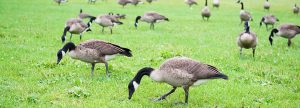Canada Geese: A Mixed Blessing
 Everyone is familiar with the ubiquitous Canada Goose (Branta canadensis), but not everyone is happy with the current numbers of geese present throughout the United States and Canada. Urban populations of resident, or non-migratory geese have exploded in recent decades, and efforts to curb populations and limit damage are now commonplace. It has not always been the case that Canada Geese were so abundant. Habitat degradation, wetland removal, and even market hunting severely limited populations of geese early in the last century.
Everyone is familiar with the ubiquitous Canada Goose (Branta canadensis), but not everyone is happy with the current numbers of geese present throughout the United States and Canada. Urban populations of resident, or non-migratory geese have exploded in recent decades, and efforts to curb populations and limit damage are now commonplace. It has not always been the case that Canada Geese were so abundant. Habitat degradation, wetland removal, and even market hunting severely limited populations of geese early in the last century.
In an effort to increase hunting opportunities, the US Fish and Wildlife Service began transplanting the giant subspecies of Canada Geese in the 1930’s to supplement local migratory populations. Not only did this effort spectacularly succeed, but the geese proliferated beyond expectations. Such efforts, combined with conservation programs and changing environmental conditions, along with their supreme adaptability, allowed Canada Geese to reach current populations in excess of 7 million birds. Migratory populations increased over the decades and are estimated at fairly stable continent-wide levels in the range of 1.5-2 million birds. The remainder of the numbers are composed of resident, or non-migratory birds that have particularly adapted to urban environments.
Parks, golf courses, agriculture, landscaping, open water associated with power plants, urban water features, and other such areas have allowed resident birds to remain further north and in much larger numbers through the winter and throughout the year in regions that could only support smaller populations of seasonal migrants in the past. While it is a clear conservation success story that should be celebrated, such abundance has naturally led to conflicts with humans in the form of nuisance complaints, potential disease transmission, and safety concerns such as conflicts with aircraft operations at and around airports. The famous “Miracle on the Hudson” where geese caused the downing of a commercial aircraft in 2009 is just one such example of the conflicts caused by Canada Geese.
Hunting opportunities did indeed increase along with exploding populations of Canada Geese, to the delight of many. However, standard hunting seasons and locations are not sufficient to control burgeoning populations. As a consequence, special non-migratory or resident hunting seasons have been instated and the federal government even issued new guidelines for the lethal management of birds and removal of nests and eggs. Without such efforts, resident goose populations have the capacity to increase at over 15% per year!
There are several methods for non-lethal dispersal of Canada Geese. Primary among these is the judicious use of pyrotechnics. A combination of 15 mm Screamer Siren and Bird Banger cartridges is particularly effective on migratory birds as they arrive each Spring and Fall and can be used to disperse resident birds any time they appear. A product that shows great promise for goose harassment is the laser. There are many varieties, but green usually performs better than red, and generally, the more milliwatts the better. Propane canons, strategically placed, can also be a highly effective dispersal tool for both migratory and resident Canada Geese. It is important to use these devices appropriately and only when birds are present within their effective range. The new Scare-Away Model R4 radio-controlled propane cannon is an ideal tool for this strategy. At airports and airfields, the Scare Wars® system offers the best available technology Canada Goose dispersal.
There are many techniques available to help promote public health and safety that may be compromised by the presence of Canada Geese and other species that have proliferated and caused unintended problems throughout their range. Let Reed-Joseph help with your Canada Goose program!







